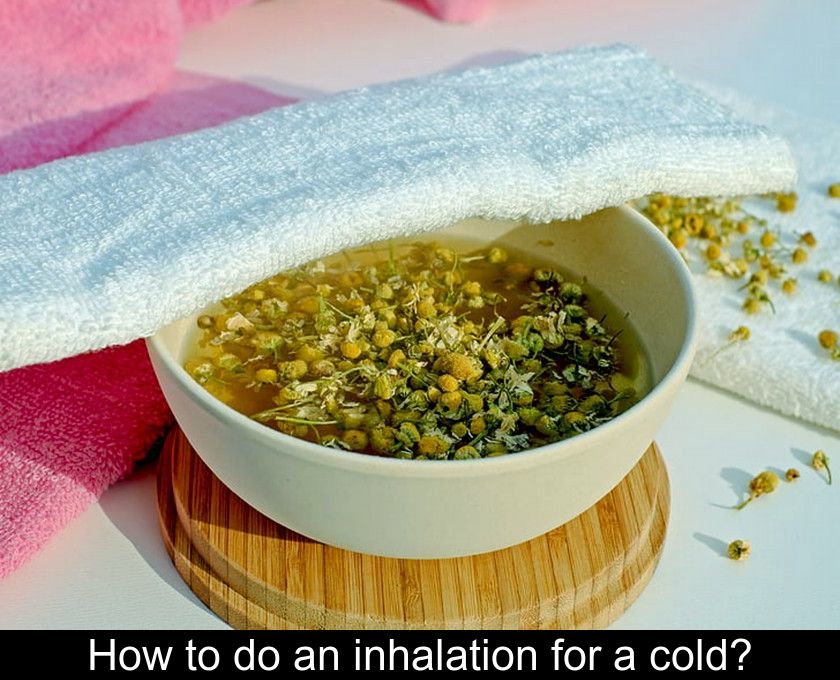How To Do An Inhalation For A Cold?
The arrival of winter signals the return of seasonal illnesses such as the common cold, sinusitis, or sore throat. To combat the surrounding viruses, it is important to clear your respiratory tract by cleaning your nose with a seawater spray or by doing inhalations with essential oils. We will explain to you how to make a homemade inhalation for the common cold.
Why do an inhalation for a cold?
The common cold is one of the most prevalent winter viruses. This illness, also known as rhinopharyngitis, manifests as an infection of the upper respiratory tract.
To combat symptoms such as a stuffy nose, headaches, sore throat, and cough, it is important to properly hydrate the irritated mucous membranes. To do this, you can certainly drink hot beverages like herbal teas or a non-alcoholic hot toddy.
But you can also do a steam inhalation for the cold because this old-fashioned remedy helps to liquefy secretions, decongest the nose, and clear the respiratory tract. With this technique, the heat from the water releases the volatile active ingredients of essential oils, and the steam helps transport them into the ENT area while rehydrating the mucous membranes.
How to do an inhalation for a cold?
In phytotherapy, the term "inhalation" can refer to two techniques:
- Dry inhalation involves directly breathing in a few drops of essential oil placed on a handkerchief, contained in an inhaler stick, or applied as a massage on your chest.
- Humid inhalation involves adding a few drops of essential oils to hot water, in a steam inhaler, or simply in a container like a bowl.
In this article, we will explain how to perform a humid inhalation to help get over your cold faster, as this second method is the most effective against ENT (ear, nose, and throat) infections.
The technique is very simple:
- Heat water to about 90°C so that it is simmering but not boiling.
- Pour the hot water into a bowl and add 5 drops of essential oils that are effective against winter viruses.
- Remove your glasses or contact lenses if you wear them before leaning your face over the bowl.
- Place a towel over your head to prevent the steam enriched with essential oils from escaping.
- Breathe in the vapors emanating from the bowl with your eyes closed for about 10 minutes.
You can repeat this type of essential oil inhalation one to three times a day for a maximum of 5 days.
What essential oils should be used for inhalation?
If you wish to do an inhalation for a cold, you can use an essential oil with respiratory benefits such as:
- Radiata eucalyptus essential oil, known for clearing the airways.
- Peppermint essential oil with analgesic and invigorating properties.
- Tea tree essential oil with antibacterial properties.
- Ravintsara essential oil with expectorant and anti-inflammatory properties.
- Thyme linalool essential oil with antiviral and antibacterial properties.
- Scots pine essential oil with antiseptic and expectorant benefits.
- Spike lavender essential oil with antibacterial and antiviral properties.
In your steam inhalations, you can also combine up to 3 essential oils in synergy to enhance their effectiveness and clear your sinuses. An easy recipe is to mix 2 drops of radiata eucalyptus essential oil with 2 drops of Scots pine essential oil and 1 drop of spike lavender essential oil.
Another tip is to add a tablespoon of coarse salt to simmering water before pouring in 5 drops of radiata eucalyptus essential oil. The coarse salt helps to moisturize the mucous membranes and facilitates the elimination of secretions by blowing your nose and coughing.
What are the contraindications for essential oil inhalation?
Although inhaling essential oils can generally be effective against the common cold, this technique is not recommended for people with asthma or epilepsy.
Additionally, the use of essential oils is contraindicated in pregnant or breastfeeding women as well as in children under 6 years old.
It's also important to know that not all essential oils can be inhaled. Seek advice from your pharmacist or a specialist when purchasing.
Finally, note that this method carries a risk of burns, which is why it's important not to use boiling water and to conduct inhalations cautiously.











